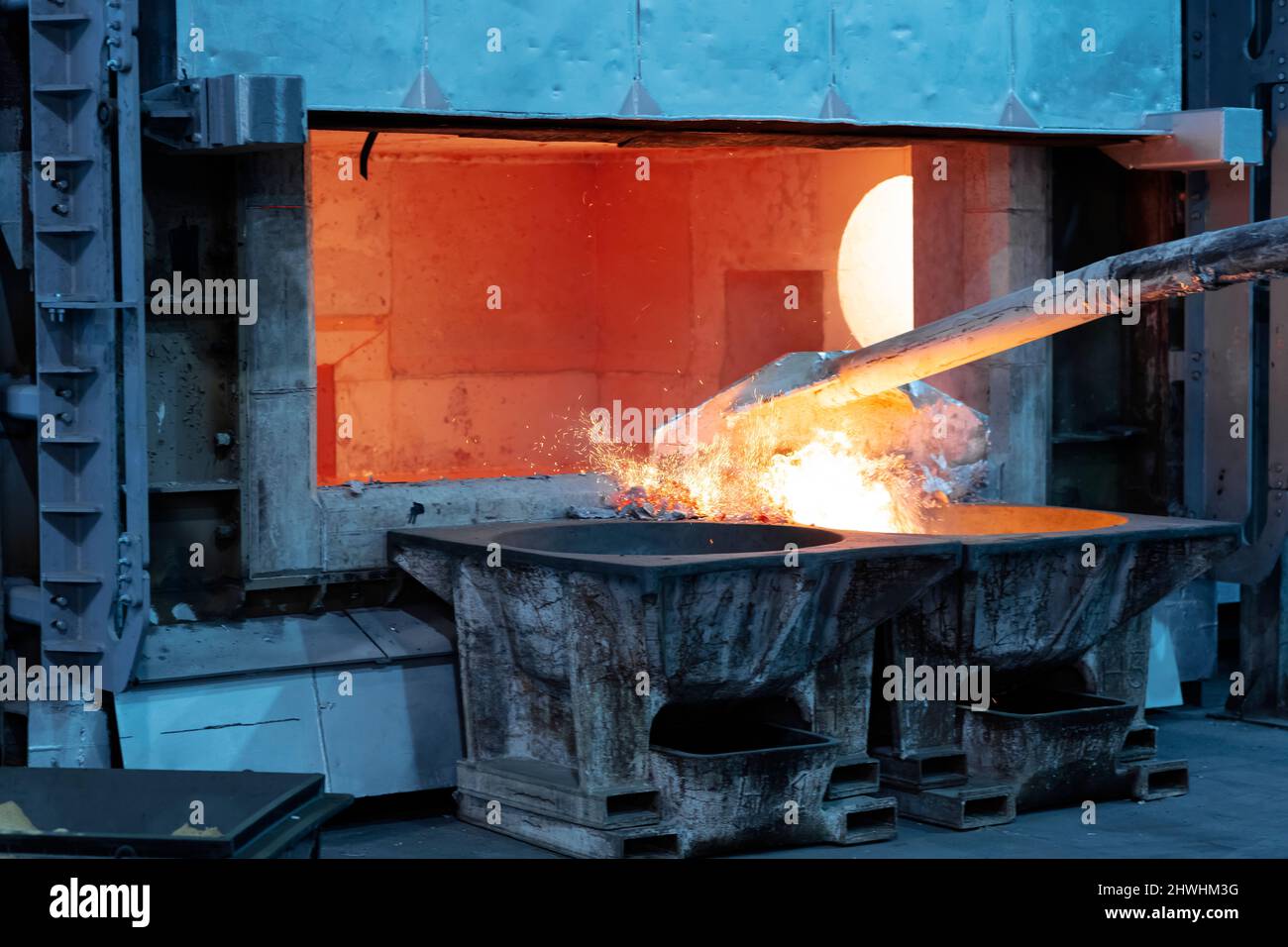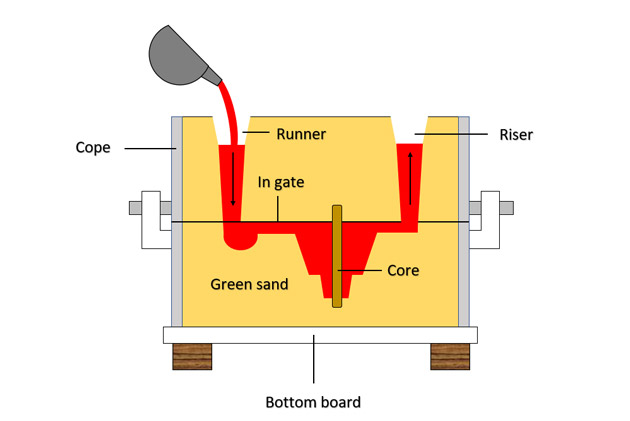How Aluminum Foundry Adds to Improvements in Aerospace Engineering
Aluminum shops are important to advancements in aerospace design. They generate light-weight, high-strength parts that are important for contemporary aircraft. With innovative spreading techniques, these shops produce complicated geometries that enhance architectural honesty. Additionally, the development of exceptional Aluminum alloys supports the market's emphasis on fuel performance and sustainability. Nevertheless, challenges continue to be in the manufacturing process. Comprehending these factors exposes the extensive impact of Aluminum on aviation's future.
The Importance of Lightweight Products in Aerospace Style
As the aerospace sector remains to advance, the value of lightweight materials comes to be significantly noticeable. The need for performance and sustainability drives designers to prioritize the usage of materials that reduce overall weight without endangering architectural honesty. Light-weight materials, specifically Aluminum, play an essential function in boosting gas efficiency, improving haul ability, and enhancing the overall performance of aircraft.
Additionally, the assimilation of these products enables for ingenious designs, enabling makers to produce even more wind resistant forms that can endure extreme problems. The decrease in weight not only reduces operational expenses however likewise adds to a reduced ecological impact, lining up with international initiatives towards sustainability in aeronautics.
Advanced Casting Techniques in Aluminum Foundries
Advanced casting techniques in Aluminum foundries play a vital role in aerospace engineering by enabling the production of accurate and light-weight parts. Developments in mold and mildew layout and accuracy spreading processes are essential in accomplishing excellent performance and structural stability. Furthermore, the advancement of lightweight alloys improves the overall effectiveness and performance of aerospace applications.
Ingenious Mold Style
Innovative mold design plays an essential duty in the performance and effectiveness of Aluminum shops, especially within the aerospace sector. By leveraging sophisticated products and strategies, modern-day mold and mildews can be engineered to withstand heats and pressures, making sure peak performance throughout the casting procedure. These layouts frequently integrate intricate geometries that permit the production of lightweight yet structurally audio elements, vital for aerospace applications. In addition, making use of computer-aided style (CAD) software application assists in exact modeling, enabling factories to imitate and fine-tune mold styles before physical production starts. This not only enhances the quality of cast components however likewise lowers waste and lead times, leading to considerable price savings. Generally, cutting-edge mold layout is a keystone of progress in Aluminum Foundry innovation for aerospace engineering.
Precision Casting Procedures
The performance of ingenious mold and mildew designs perfectly incorporates with precision spreading procedures, which are important for generating high-grade Aluminum elements in aerospace design. These procedures, consisting of sand casting, die spreading, and investment spreading, ensure the development of complex geometries with tight tolerances. Advanced strategies like vacuum spreading and stress pass away casting enhance the integrity and surface finish of the end products. Accuracy casting decreases product waste while maximizing the mechanical buildings of Aluminum, essential for aerospace applications. Additionally, employing real-time tracking and progressed simulation devices throughout the casting procedure enables prompt adjustments, causing improved quality assurance. Jointly, these accuracy casting processes placement Aluminum shops at the forefront of aerospace development, sustaining the market's need for integrity and performance.
Lightweight Alloy Development
As aerospace designers look for to improve fuel efficiency and performance, light-weight alloy growth becomes an essential focus in Aluminum factories. These shops employ sophisticated spreading techniques to produce alloys that supply premium strength-to-weight ratios. Developments in alloy composition, including the consolidation of aspects like lithium and magnesium, allow the production of materials that stand up to severe conditions while reducing general aircraft weight. Methods such as die spreading and financial investment casting facilitate the precision manufacturing of complicated shapes, which are vital for aerospace applications. In addition, ongoing study intends to enhance these alloys for improved mechanical properties and enhanced sturdiness. By prioritizing lightweight alloy growth, Aluminum factories greatly add to the development of aerospace engineering, leading the way for much more effective and lasting airplane layouts.

Enhancing Structural Honesty Via Aluminum Parts
Aluminum elements provide substantial benefits in boosting architectural honesty within aerospace design. Their light-weight nature contributes to total performance while keeping toughness, which is vital for aircraft efficiency. Additionally, the stress resistance buildings of Aluminum help guarantee the resilience and dependability of aerospace frameworks under different functional problems.
Light-weight Product Benefits
While standard products usually jeopardize weight for toughness, making use of Aluminum parts in aerospace design supplies considerable benefits in architectural stability. Aluminum's light-weight nature adds to general style efficiency, permitting even more streamlined aircraft that eat less gas, consequently enhancing sustainability. The product's excellent strength-to-weight proportion assurances that components keep resilience without adding unneeded mass. This quality cultivates improved performance and agility in trip, along with optimized payload capacities. In addition, Aluminum's resistance to corrosion extends the life expectancy of aerospace frameworks, decreasing maintenance costs and enhancing safety and security. As producers significantly take on Aluminum alloys, the aerospace market experiences a transformative change in the direction of more efficient and effective design remedies that prioritize both performance and environmental obligation.
Stress And Anxiety Resistance Characteristics
Various products possess one-of-a-kind properties, Aluminum's exceptional stress and anxiety resistance stands out as a critical element in boosting the structural stability of aerospace components. This resistance plays an essential duty in guaranteeing that airplane can stand up to numerous operational stresses, consisting of tiredness, effect, and environmental problems. Aluminum alloys, especially crafted for aerospace applications, exhibit high tensile strength while preserving light-weight features, allowing designers to develop more reliable structures - Aluminum Foundry. In addition, the ability of Aluminum to withstand cyclic loading without significant contortion adds to the durability and dependability of aerospace parts. As improvements continue in Aluminum Foundry methods, the growth of stress-resistant Aluminum parts promises more improvements in efficiency, security, and effectiveness throughout the aerospace market, strengthening Aluminum's function as a favored material in contemporary engineering
Gas Performance Improvements Driven by Aluminum Innovations
As the aerospace market seeks to improve gas performance, cutting-edge uses Aluminum have actually become a crucial option. Aluminum's light-weight nature especially reduces airplane weight, enabling for lower fuel consumption throughout flight. This reduction in weight is vital, as also tiny declines can result in significant improvements in general fuel economic situation.
Advanced Aluminum alloys, created for improved strength and toughness, allow producers to develop parts that preserve structural integrity while lessening mass - Aluminum Foundry. Furthermore, the assimilation of Aluminum in airframes and engine parts facilitates improved the rules of aerodynamics, adding to decreased drag and boosted effectiveness
The fostering of Aluminum in aerospace not just meets the demand for fuel-efficient layout yet likewise straightens with regulatory stress for reduced emissions. As these technologies continue to progress, they play a significant function in establishing brand-new standards for fuel performance, making certain that the aerospace sector can meet growing economic and ecological obstacles.

The Duty of Aluminum in Sustainable Aviation Practices
The raising focus on sustainable aeronautics practices has actually placed Aluminum as a necessary material in the quest for greener airplane layout. Understood for its lightweight residential or commercial properties, Aluminum significantly reduces aircraft weight, causing reduced gas usage and emissions. Its recyclability better enhances its sustainability account, as Aluminum can be recycled indefinitely without loss of high quality. This characteristic sustains a round economy within the aeronautics field, reducing waste and resource site depletion.
Advancements in Aluminum alloys have actually improved their stamina and deterioration resistance, allowing for longer solution life and minimized upkeep requirements. These developments facilitate the growth of a lot more efficient aircraft structures, adding to total sustainability efforts. Furthermore, Aluminum's thermal conductivity plays an important function in energy-efficient layouts, boosting systems such as warm exchangers. Jointly, these characteristics emphasize Aluminum's essential role beforehand lasting aviation, lining up with worldwide initiatives targeted at decreasing the environmental effect of air travel.
Obstacles Encountered by Aluminum Foundries in Aerospace Manufacturing
While Aluminum factories play an essential function in aerospace production, they face considerable challenges that can impact manufacturing efficiency his response and high quality. One major challenge is the stringent quality control requirements required in the aerospace sector. Any flaw can compromise security and performance, requiring extensive evaluation procedures that expand manufacturing timelines. Additionally, factories usually emulate rising and fall resources prices, which can affect rates and profitability. The complexity of Aluminum alloys made use of in aerospace applications further complicates the manufacturing process, as accurate formulas are vital for achieving preferred mechanical buildings. Skilled labor scarcities hinder the capacity to keep top quality manufacturing degrees. Environmental regulations enforce constraints on discharges and waste management, needing shops to invest in sustainable methods, which can be cost-prohibitive. These factors collectively create a landscape where Aluminum foundries need to constantly adapt to meet the evolving demands of aerospace manufacturing while making sure safety and compliance.
Future Fads in Aluminum Applications for Aerospace Engineering
With developments in technology and increasing needs for effectiveness, the future of Aluminum applications in aerospace design is poised for significant improvement. The combination of innovative Aluminum alloys and composites is expected to improve strength-to-weight ratios, causing more fuel-efficient airplane styles. On top of that, advancements in additive manufacturing methods will certainly permit the production of complicated Aluminum structures that were previously difficult, optimizing performance and reducing waste.

Lasting techniques will play an important function, with a growing focus on recycling Aluminum to lessen ecological impact. The aerospace sector is most likely to accept smarter producing processes, such as automation and artificial knowledge, making sure higher quality and precision in Aluminum elements. Cooperations in between Aluminum factories and aerospace companies will certainly foster research study and advancement, paving the way for new applications that satisfy the rigid needs of modern-day aerospace engineering. In general, the future looks assuring for Aluminum's function in shaping the skies
Often Asked Questions
What Are the Environmental Impacts of Aluminum Manufacturing in Aerospace?
The ecological effects of Aluminum manufacturing in aerospace include considerable power usage, greenhouse gas discharges, and habitat interruption. Additionally, mining procedures can bring about soil degradation and see post water contamination, raising issues about sustainability and eco-friendly balance.
How Does Aluminum Compare to Various Other Materials in Aerospace Applications?
Aluminum uses a special mix of light-weight buildings, deterioration resistance, and cost-effectiveness compared to various other products. Its high strength-to-weight proportion makes it particularly beneficial for aerospace applications, improving gas effectiveness and overall efficiency in aircraft layout.
What Certifications Do Aluminum Foundry Employees Requirement for Aerospace Projects?
Aluminum Foundry workers need specialized training in metallurgy and spreading techniques, in addition to understanding of aerospace industry requirements. Accreditations in quality assurance and safety methods are additionally essential to assure compliance with rigorous aerospace job requirements.
Are There Any Security Interest In Using Aluminum in Aerospace Design?
Safety worries concerning Aluminum in aerospace design consist of vulnerability to tiredness, corrosion, and stress and anxiety fractures. Appropriate therapy and alloy selection are necessary to mitigate these risks, ensuring architectural honesty and general security in aerospace applications.
How Does Aluminum Recycling Benefit the Aerospace Industry?
Aluminum reusing significantly benefits the aerospace sector by reducing material expenses, minimizing environmental impact, and conserving energy. This sustainable practice enhances the industry's performance while advertising using light-weight, high-performance elements in airplane production.
Advanced casting techniques in Aluminum shops play a critical role in aerospace engineering by allowing the production of accurate and lightweight elements. Innovative mold design plays a necessary duty in the performance and performance of Aluminum foundries, specifically within the aerospace field. As aerospace designers look for to boost fuel effectiveness and performance, light-weight alloy growth comes to be a vital focus in Aluminum shops. Aluminum alloys, especially engineered for aerospace applications, display high tensile strength while preserving light-weight attributes, making it possible for engineers to design a lot more effective frameworks. Cooperations in between Aluminum factories and aerospace companies will certainly promote research and growth, paving the means for new applications that meet the stringent demands of modern aerospace design.